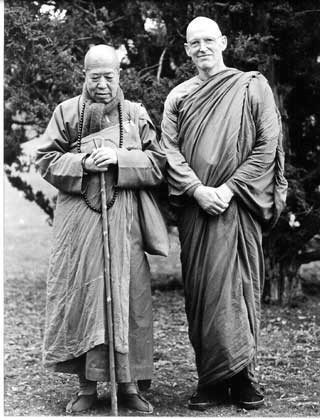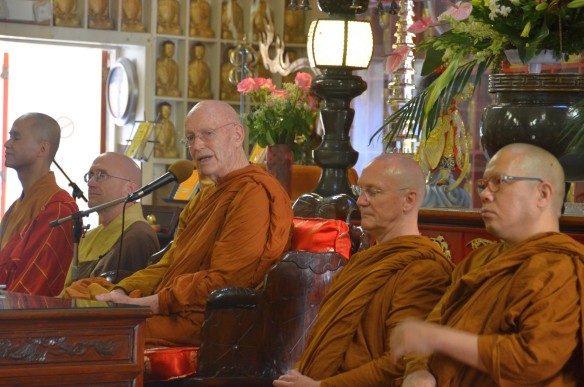In 2010, Ajahn Sumedho retired from his duties as the Abbot of Amaravati Monastery and leader of the Western Ajahn Chah Sangha. During the last few years of his retirement, he lived in Thailand living the simple life of a forest monk. So, it was a treasured occasion to able to attend a Dharma talk from such a Dharma Elder.
In the Buddha Hall, Ajahn Sumedho gave an hour Dharma Talk sharing his own personal journey practicing the Dharma.
In the Buddha Hall, Ajahn Sumedho gave an hour Dharma Talk sharing his own personal journey practicing the Dharma. He spoke about how he started as a young American living the free and hedonistic life in the 1960s but not finding any true happiness. After finishing his graduate studies at UC Berkeley, he went to Asia to pursue his interest in Eastern thought.
He wanted to go deeply into the Buddha’s teachings and put it into practice, so he went to Thailand and became a novice monk. He lived a simple life meditating in a hut where the only book he kept was on the Four Noble Truths. At that time, there were very few people in Thailand who spoke English, so he was not able to converse with others much. However, the Thai were kind and supported him as a Dharma practitioner.
Over the years, his emphasis has been on abiding in the awareness of the mind rather than the discriminating, thinking process and observing the world through the Four Noble Truths.
Later he met Ajahn Chah and received training within the monastic form. Over the years, his emphasis has been on abiding in the awareness of the mind rather than the discriminating, thinking process and observing the world through the Four Noble Truths. He had to let go of the American tendency to “idealize” things and wanting things to be “perfect.” Dharma was about the “way things are,” not how they “ought to be,” which leads to dissatisfaction and delusion.
Ajahn Sumedho emphasized that the Dharma was about reality and not a naive idealism. Reality is not perfect, but instead, characterized by suffering and impermanence. They are not to be grasped and held onto.
Ajahn Sumedho concluded his talk by saying that his respect for the Dharma over the years has increased to 100% and that he has applied the Four Noble Truths to his life in all situations. Everything is impermanent. He exhorted everyone to not believe in what their minds tell them, but rather trust in the awareness of the mind and see that the nature of all phenomena is change.
Dharma friendships between the two Sangha communities

Picture of Venerable Master Hua & Venerable Ajahn Sumedho, whose meeting represented a coming together of the Northern (Mahayana) and Southern (Theravada) strands of Buddhism.
Ajahn Sumedho has had a long history with DRBA beginning with his meeting with the Venerable Master in the 1980s. Master Hua said that they were fellow cultivators in past lives and that together they could help bring the Northern and Southern Schools of Buddhism back together again [i.e. the Mahayana which is generally located in the Northern Asia while Theravada is located in Southeast Asia.]
Ajahn Sumedho commented on how he felt the same aura around Master Hua as his own teacher, Ajahn Chah. He said it was rather unexpected because he did not think he would meet two people like that in the world.
While introducing Ajahn Sumedho at the start of the lecture, Rev. Heng Sure shared how the Venerable Master told him to take Ajahn Sumedho as a role model for being a Western Bhikshu, someone who had truly made the resolve to end the cycle of rebirth.
DM Heng Lyu, the Abbot of CTTB, paid his respects to Ajahn Sumedho who was his preceptor in 1991 when he became a monk. The Venerable Master asked Ajahn Sumedho to serve as the preceptor during that ordination platform. The Dharma friendships between the two Sangha communities are quite deep.
After the talk, Rev. Heng Sure and DM Heng Lyu expressed their gratitude on behalf of everyone for Ajahn Sumedho’s visit. DM Lyu wished Ajahn Sumedho could live to be as old as Venerable Master Hsu Yun, 120 years old. Rev. Heng Sure quoted the Venerable Master by saying that to establish the Dharma in the West, we should “Tell the South not to run farther to the south, and tell the North to turn around from their direction north, and we will all meet in the middle.” This visit was truly a rare and historic moment.

